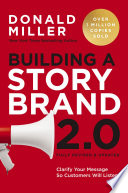

In traditional marketing, brands often position themselves as the heroes of their own stories. However, 'Building a StoryBrand 2.0' flips this narrative by positioning the customer as the hero and the brand as the guide. This shift is crucial because it allows customers to see themselves in the story, making the brand’s offerings more relatable and appealing. By focusing on the customer’s journey and challenges, brands can create a more engaging narrative that resonates on a personal level, ultimately leading to higher engagement and conversion rates.
Continue readingThe StoryBrand Framework is a seven-part process designed to help businesses clarify their messaging. At its core, the framework is based on the principles of storytelling. It posits that every effective marketing message should follow a narrative structure where the customer is the hero, and the brand acts as a guide. The seven parts of the framework include: 1) A character (the customer) 2) A problem (the customer's pain point) 3) A guide (the brand) 4) A plan (how the brand can help) 5) A call to action (what the customer should do) 6) Avoiding failure (what's at stake if the customer doesn't act) 7) Success (the positive outcome from engaging with the brand). This structure allows brands to connect with customers on an emotional level, ensuring that their messages resonate and drive action.
Continue readingOne of the key tenets of 'Building a StoryBrand 2.0' is the importance of clarity in messaging. Many businesses struggle with communicating what they do and how they can help their customers. The book emphasizes that a clear message will attract customers more effectively than a complicated one. It encourages brands to eliminate jargon and focus on the customer’s needs and desires. By honing in on what the customer truly wants and presenting a straightforward solution, businesses can create a compelling narrative that draws customers in and converts them into loyal clients.
Continue readingA compelling call to action (CTA) is essential for guiding customers toward the next steps they should take. The book discusses the difference between direct CTAs (like 'Buy Now') and transitional CTAs (like 'Learn More'). Both types serve different purposes in the customer journey. A strong CTA not only tells customers what to do next but also reinforces the value of taking that action. By clearly articulating the benefits of engaging with the brand, businesses can increase the likelihood of conversion and build a stronger relationship with their audience.
Continue readingUnderstanding the problems that customers face is a fundamental aspect of effective marketing. 'Building a StoryBrand 2.0' emphasizes the need for brands to deeply understand their customers' pain points and challenges. This understanding allows businesses to craft messages that resonate with their audience, demonstrating empathy and positioning the brand as a solution provider. By addressing these problems head-on, brands can build trust and credibility, making it more likely that customers will turn to them for solutions.
Continue readingThe Brand Script is a tool introduced in the book to help businesses outline their messaging according to the StoryBrand Framework. It serves as a blueprint for all marketing materials, ensuring consistency and clarity across different platforms. The Brand Script encourages businesses to answer key questions about their customers, their problems, and how the brand can help. By having a clear and concise Brand Script, companies can streamline their marketing efforts and ensure that every communication aligns with their overarching narrative.
Continue readingStorytelling is a powerful tool in marketing, as it taps into the emotional side of consumer behavior. 'Building a StoryBrand 2.0' highlights how stories can create connections, build trust, and foster loyalty. By weaving narratives into marketing strategies, brands can engage customers more effectively, making their messages memorable and impactful. The book encourages businesses to embrace storytelling as a core component of their marketing strategies, ultimately leading to stronger relationships with their customers and increased brand loyalty.
Continue reading